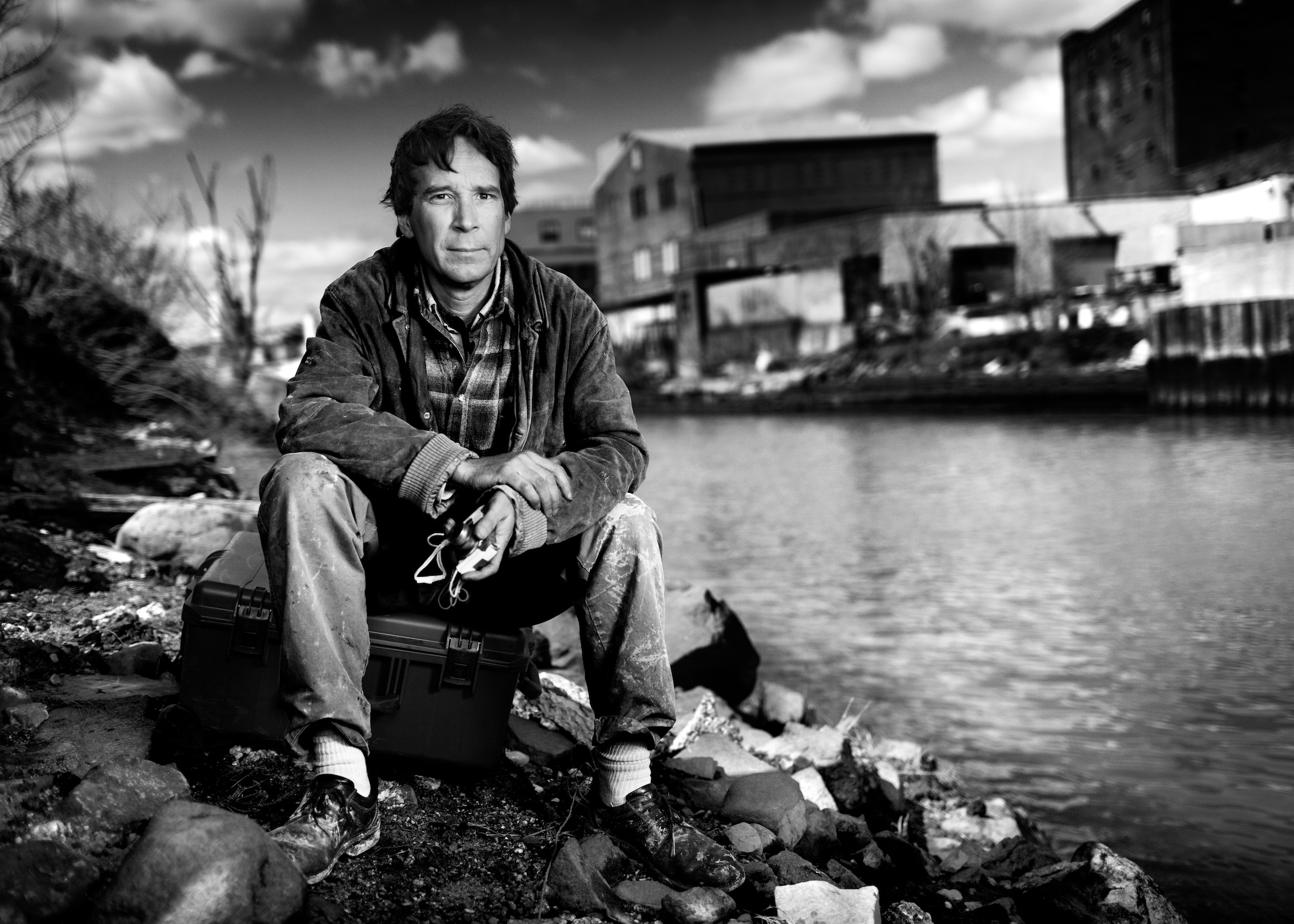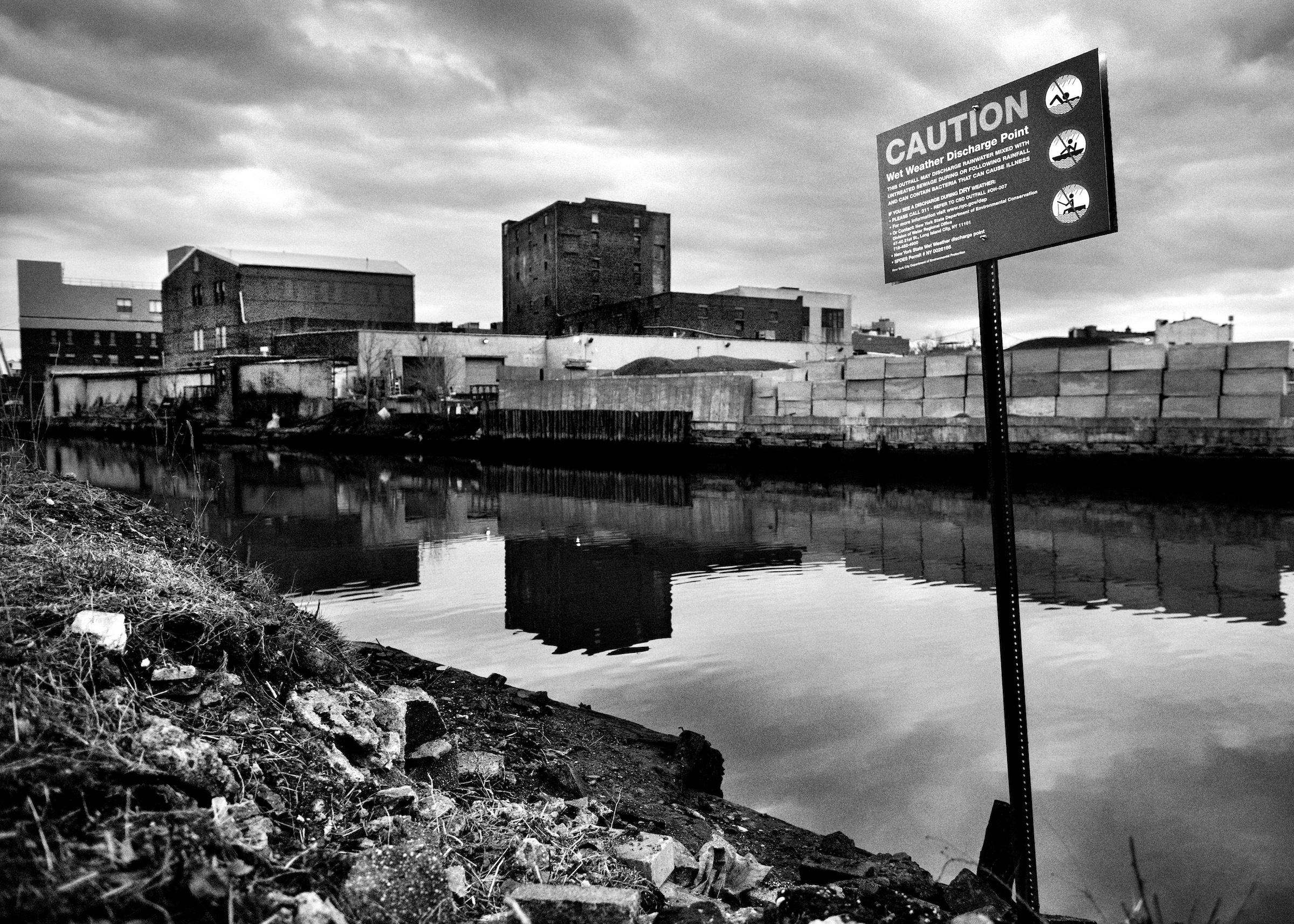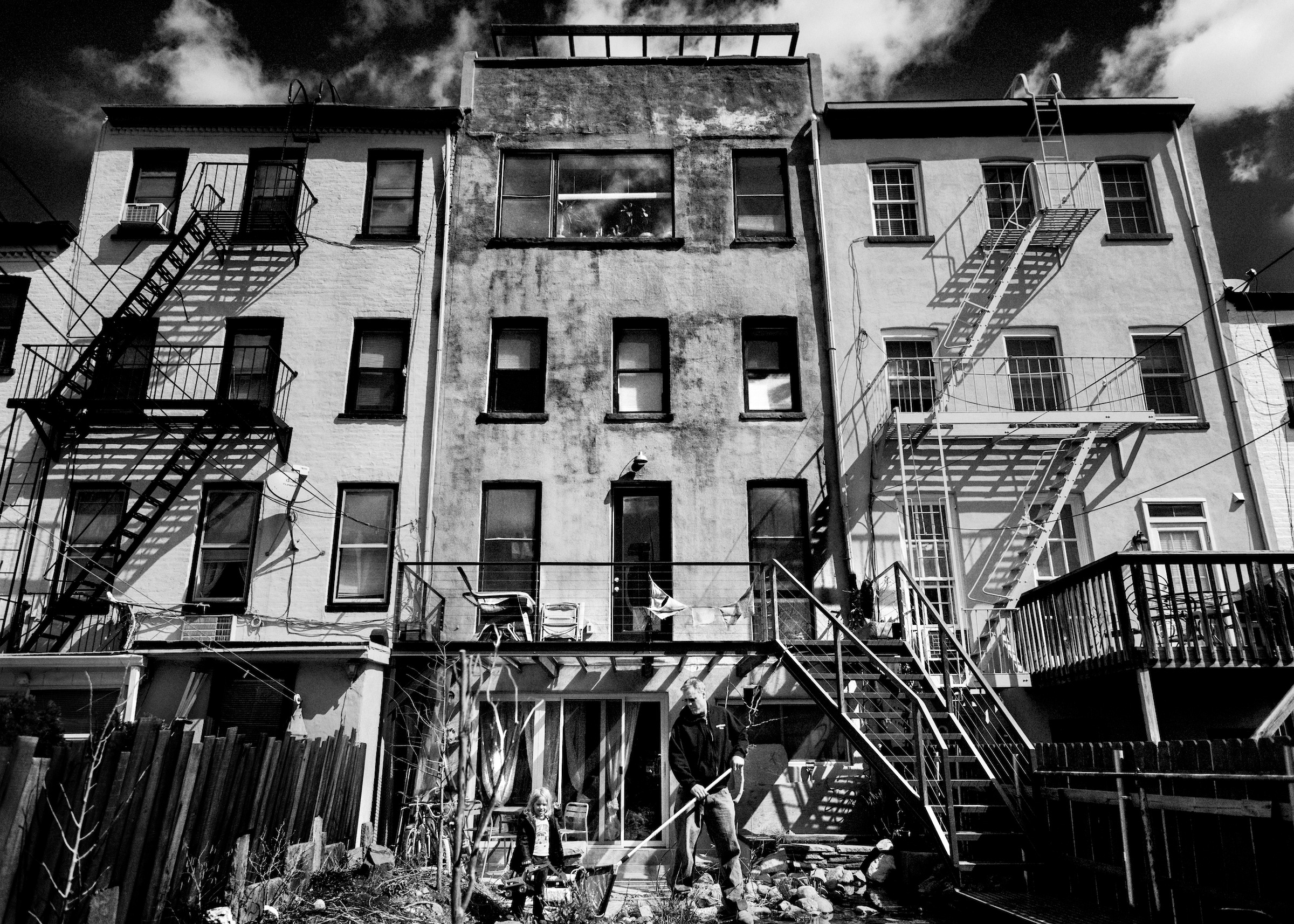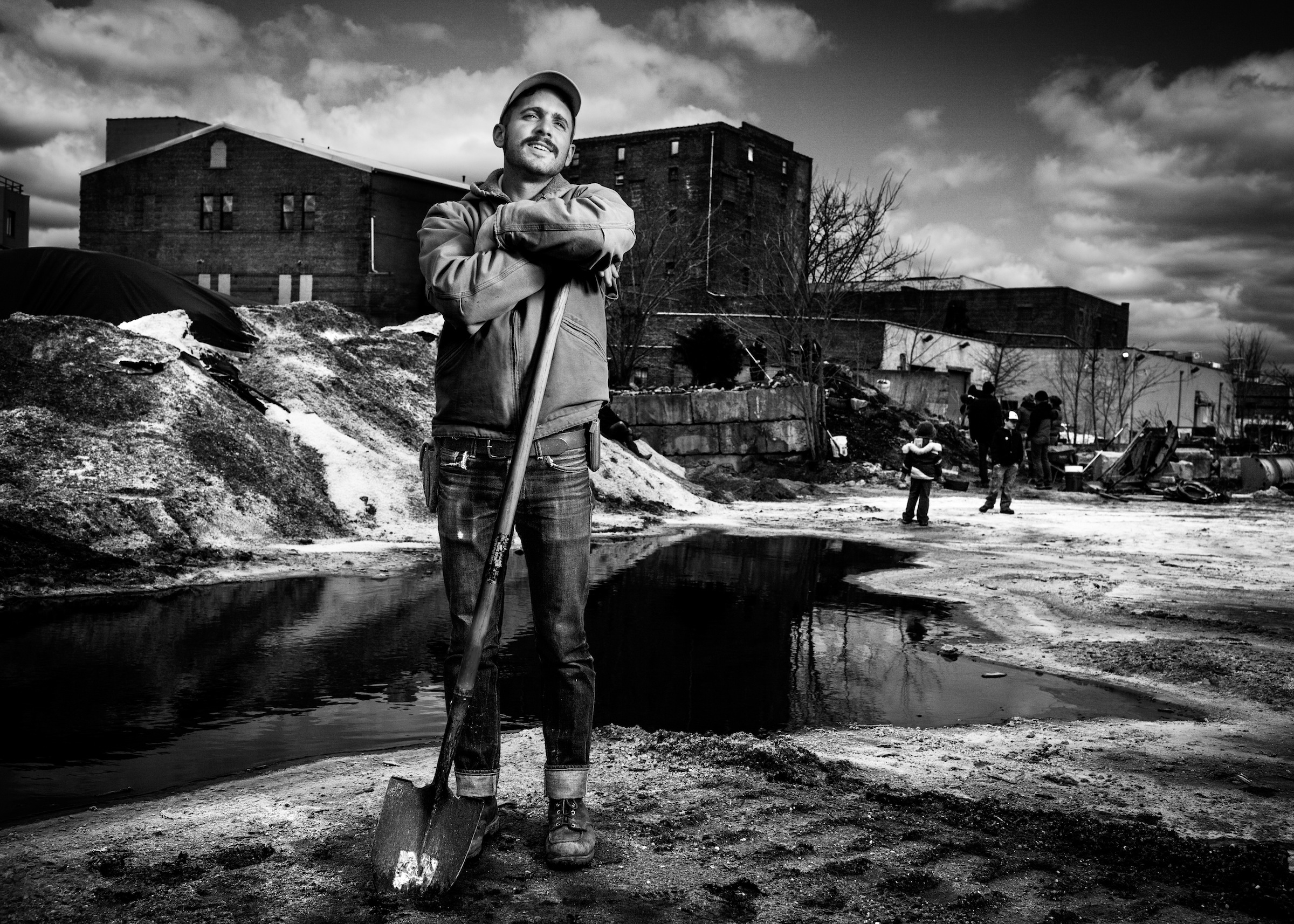The Gowanus Canal is where things go to die. Its 1.8 man-made miles, which cut through Park Slope and Carroll Gardens and lead out into the Atlantic Ocean, are filled with murky green water, bacteria, human excrement, dead animals, and what must be a landfill’s worth of trash, from scrap metal to used condoms.
At its bottom is a layer of oil-based sludge so toxic that the U.S. Environmental Protection Agency is proposing to spend up to $500 million on a decades-long project to remove and treat it.
In the late 1800s, factories used the canal to transport goods out into the Atlantic. In the mid 1900s, gas and oil companies dumped waste in it.
Now, people pay millions to live right next to it.
I first learned about the Gowanus in a canoe. A local environmental planner and part-time activist named Eymund Diegel, who does this sort of thing for fun, took me on a brief trip last summer paddling through its floating garbage bags and gurgling effluvia. The canal’s main problem, beyond the sludge at the bottom, is the fact that millions of gallons of sewage pour into it each year, he explained to me.

New York is a city of concrete and asphalt. It’s largely impervious. Every time it rains, the rainwater rolls over the smooth surface of the streets and into metal sewer grates. On the way, it picks up whatever it comes across: oil, soot from car exhaust, toxic chemicals. Normally, the dirty rainwater ends up passing through a treatment plant. But on particularly rainy days, the system can’t handle the added volume. To avoid overloading treatment plants, water is directed toward sewer outflow points throughout the city. Some of these pour right into the Gowanus.
As global warming causes more — and more intense — storms, places like the Gowanus are especially vulnerable. Hurricane Sandy provided a clue to the potential disaster at hand: the storm forced 1.6 billion gallons of sewage into New York City’s waterways.
As we canoed down the canal, I saw several of the outflow points, which are marked with green signs warning people to get out of the way when it rains. Even without storms like Hurricane Sandy, sewage is a big problem. Each year, 370 million gallons of rainwater, mixed with whatever you flush down your toilet goes into the Gowanus. And because the canal sits at one of the area’s lowest points, dirty rainwater that doesn’t end up in sewers still finds its way into the canal.
Man and topography have conspired to make Gowanus the shithole it is. And yet there are some who believe the canal can be beautiful.
Not that it was ever meant to be. In the mid 1800s, Brooklyn turned from farmland into factories and warehouses. Manufacturers needed a way to transport goods out into the Atlantic, and so, in 1849, the state of New York authorized the construction of the canal. For the next 100 years, it was vital to the city’s industry. Much of the brownstone that makes up “Brownstone Brooklyn” was brought into the borough through the Gowanus. And despite being only two miles long, the canal was a critical thruway for coal gas manufacturing plants, oil refineries, and chemical plants.
Then, in the 1950s, as Brooklyn’s network of highways, including the Brooklyn-Queens Expressway, fell into place, the Gowanus fell into disuse and disrepair. The Army Corps of Engineers stopped dredging the bottom of the canal, and in 1961, a tunnel that flushed hundreds of millions of gallons of freshwater into the canal broke. No one bothered fixing it. The tunnel’s now functioning, but not at full capacity.

In the 1960s and seventies, the era of industrial Brooklyn was also coming to an end. Factories around the canal closed. Ships stopped coming and going. Today, one company still relies on the canal to transport scrap metal, but that’s just about it.
For decades, the Gowanus Canal has been mostly unused, a foul-smelling reminder of a working-class neighborhood’s industrial past. No one thought it could be a beautiful body of water. Many thought it should just be paved over. And so it’s sat.
On a recent sunny Saturday, the Gowanus Alliance held its first “Clean and Green” event of the year. The nonprofit, which employs three people and has a budget of about $150,000, has been hosting the events for four years in a city-owned lot that abuts the canal on Fifth Street and Second Avenue. The lot is still used to store salt for winter storms, but during the warm months it’s overtaken by volunteers who spend their weekends composting dirt, building birdhouses, and tilling soil for gardens that are planted around the canal to help catch water runoff.
On this particular day, Diegel, my trusty canoe-paddling tour guide, stood in the center of the lot attempting to fly a large yellow kite, but the strong wind kept knocking it down to the ground. Most weekends, weather permitting, Diegel straps a camera onto a kite or balloon. He’s hacked the camera to take a photo every 10 seconds. These pictures let Diegel see the darker areas of soil and pavement surrounding the canal — an indication of water runoff. He shares that information with the other volunteers, who then plant water-absorbing gardens in those areas.
Diegel’s unusually dedicated, but he’s by no means alone in his enthusiasm for the Gowanus. He’s part of a loosely connected contingent of area residents who care deeply about the canal and the quality of life surrounding it.
There’s Hans Hesselein, the director of the Gowanus Canal Conservancy. Every week, he leads about 50 volunteers to the canal’s edges to compost and plant gardens. He also brings kids and adults down to the canal and speaks to them about the environmental problems facing the canal and New York City.
There’s Susannah Drake and her team at dlandstudio, which has designed a “sponge park” to sit along the Gowanus. The park, which will be built over the next few years, will include dozens of acres of green space around the canal. It’ll serve two purposes: to transform the concrete edge of the canal into a pleasant recreational space, and to absorb as much water as possible.
And then there’s Gennaro Brooks-Church, who’s dedicated his house, of all things, to the cause.
A block and a half from the canal, on a street in Carroll Gardens lined with otherwise indistinguishable brick townhouses, sits one house more conspicuous than the rest. Most of the houses on Second Street have front yards paved over with concrete. Gennaro Brooks-Church’s yard has a water-absorbing garden and a five-foot-deep pond filled with goldfish.
Brooks-Church, an environmentally conscious contractor, has invested tens of thousands of dollars into making his townhouse water-neutral. No water that lands on his property leaves it.
His house, he believes, is what New York will look like if residents take water runoff, sewer overflow, and wastewater management seriously. With many of the experiments being put in place around the Gowanus on view here, Brooks-Church’s house provides a glimpse — perhaps an overly idealistic glimpse — of the future.
When I arrived, Brooks-Church stood in his front yard speaking American-accented Spanish to a group of contractors. His wears his blond hair shaggy and his T-shirt and cargo shorts rumpled.
It was time for the tour.
He first pointed out the pond: at about five feet wide and deep, it can retain over 100 gallons of water. Rain collects in it and slowly evaporates. If the pond overflows, the water dribbles onto Brooks-Church’s front yard, which acts as a bioswale, a fancy term for a landscaped area designed to capture water. The plants Brooks-Church chose to surround the pond are all native to New York, and he’s convinced the city to allow him to plant more in the sidewalk tree pits in front of his house.
Brooks-Church contrasted his yard with his neighbor’s, which is paved over with concrete. That property, he explained with a look of disdain, doesn’t absorb a cup of water. In the next few months, he plans to install a funnel from his neighbor’s roof to catch some of it himself.
Brooks-Church then took me into the first floor of his townhouse. In the kitchen, light streamed in through floor-to-ceiling windows as his girlfriend, a baby in her arm, cooked up some eggs on a stainless steel range. Their two other children ran around the townhouse on floors made of salvaged wood.
We walked through to the backyard. There, Brooks-Church leaned down and with his hands scooped up some dirt to show me the milk crates he’d buried just underneath the surface. During heavy storms, he said, the crates act as a basin — they allow more rainwater to enter the ground, instead of overflowing his backyard.

We walked back into the house and headed upstairs. On the third floor, next to his desk and an expansive collection of books about construction and the environment, are a dozen fish tanks and glass vases that contain pebbles, plant life, and bacteria-infused water. Each is an informal experiment to see how different combinations of pH, plants, and bacteria interact with each other. This summer, he’ll attempt to mimic the most successful experiment — the one that causes matter to decay most rapidly — in the Gowanus. He hopes he can help the toxic sludge at the bottom decompose naturally.
We then went to the roof.
As honeybees from Brooks-Church’s personal hive swarmed around my head, he told me about the lightweight soil that makes up his rooftop’s water-absorbing garden. Roofs can’t support the weight of dense, saturated dirt, so he’s mixed in treated Styrofoam pellets to make the soil lighter.
Brooks-Church, like other activists dedicated to the canal, considers the money and time he pours into porousness to be a gratifying on their own terms. It got too stressful to try to change others’ minds, he told me. It was much more satisfying to focus on his own impact.
“I think I had a bit of a Jesus complex where I was trying to change the world,” he told me. “But really what happened is, I changed.”
His parents, he recounted, were radicals who became fugitives, wanted for blowing up a Bank of America in Berkeley, Calif. as an act of protest against the Vietnam War. Brooks-Church grew up on the run, traveling to 30 countries with his fugitive parents, who were being tracked at one point by authorities in Canada, Spain, France, Luxembourg and England.
Both his mother and father eventually turned themselves in. Don Louis Church surrendered to police in the 1970s, and spent eight years in prison. He was arrested again in 1983 after attempting to pick up $6 million in cocaine from a storage locker in Arkansas. His mother decided to emerge from the underground and surrender to police in 1988, when Brooks-Church was seventeen.
“I’m here to clear my name and to simplify my family’s life,’ Mary Kathleen Brooks told the Los Angeles Times outside of an Oakland courtroom. The authorities lacked enough evidence to convict her of the bombing.
After turning eighteen, traveling and working as a carpenter, dropping out of college in California and bumming around some, Gennaro studied photography at Columbia University and settled down in New York.
His mom now lives high up in the mountains in Spain, using solar panels to light her house.
Brooks-Church rattled all of this off as if he was still talking about variants of mulch.
“So that kind of gave me a bit of a rebel outsider attitude,” he said dryly.
We wrapped up the tour and walked back out in front of his house.
After dabbling in a couple of different professions, Brooks-Church and his girlfriend bought a townhouse in Carroll Gardens in 2008. The place was dilapidated; termites had chewed through the first two floors. Brooks-Church had built some furniture when he worked as a carpenter in his late teens, but he’d never rebuilt an entire house. But as he started tinkering with his house, he realized it made him happy.
For years, he’d traveled the globe and flitted between professions, searching for what he wanted. The house provided the answer.
Brooks-Church sees his water-neutral house and his work around the Gowanus as an extension of his parents’ political past. He’s just replaced militancy with mulch. Brooks-Church may be less extreme than his parents, but he’s equally passionate.
After the house tour, Brooks-Church took me in his Ford Fiesta to pick up something from a storage space he owns in Crown Heights.
We started slowly down the ten miles of four-lane pavement known as Atlantic Avenue.
As we waited at a stoplight outside the Barclays Center, two construction workers ripped up asphalt next to the car. One, wearing earmuffs to prevent hearing loss from the sound, drove the drill bit of his jackhammer into the pavement. It pulsated up and down, the worker’s arms shaking from the pressure, until, finally, the asphalt cracked.
Brooks-Church slowly rolled up his window.
“We’re like masters of the universe,” he said. “Once we found oil, it was like going from pot to crack. We’ve essentially turned our planet into a crack house.”
“Isn’t it our right, as Americans, to just go about our day, not worrying about our water, about pavement?” I asked, expecting to push his buttons. I understood Brooks-Church’s environmentalist mentality, but I wondered how he expected others to follow in his footsteps. Did he expect ponds and gardens and bioswales to line Atlantic Avenue? For people to suddenly worry about sewers and tree pits and whether their yards absorb enough water? “Isn’t not caring,” I asked, “a definition of freedom?”
“It definitely is a definition of freedom,” he said. “It’s not my definition of freedom. It’s not surprising to me that people are rioting outside our embassies right now. It’s surprising that somebody would be surprised.”
Smoke from an eighteen-wheeler next to us billowed into the back window.
“Are you equating flushing a toilet with conflict in the Middle East?” I asked.
“In the same way that when a butterfly flaps its wings, it creates a tornado somewhere,” he said.
I sat silently for a few minutes, staring at the concrete and asphalt world around us. During the next rainstorm, this pavement would contribute to the further desecration of the Gowanus.
“Concrete is probably the most amazing discovery of humankind. It’s mind-boggling what we’ve accomplished with it,” Brooks-Church said.
We inched our way down Atlantic Avenue, his Fiesta filled with construction noise and exhaust.
“It’s easy, it’s mindless, it’s cheap — it’s pretty amazing, and I think it has its place,” he continued. “Just like there are times when killing someone has its place.”
But, like war, laying down concrete and asphalt has become a reflex, not the last resort, he said. Instead of seeing the materials for what they are, wondrous and powerful tools that should be used with care, like guns, we’ve seen convenience and have become gluttonous.
As we continued down Atlantic in his car and away from Brooks-Church’s green mecca of a house, even he seemed to lose enthusiasm for cleaning up the world. When you think about environmental concerns on a global scale, he told me, life can be a little depressing.
Surrounded by concrete and apathy, it’s hard to think that one house, or even $500 million of EPA money, was going to change much. The work he’s doing on Second Street and volunteers are doing around the Gowanus is nice, but is it nearly enough?
That’s part of the reason Brooks-Church considers his work more of a personal mission than a world-changing ambition: if he thinks about the actual size of the problem he’s up against, it’s easy to feel defeated. Same goes for the other activists around the Gowanus — they focus on themselves, lest they get depressed.
Brooks-Church told me his activism, green thumb, and environmentalism are his personal ways of not feeling miserable. He thinks global warming is already wreaking havoc that’s far beyond his control, but he wants to be on the right side of history and do his part, no matter how small.
“I think ultimately Mother Earth is going to win,” he said as we inched along in his car. “People are not going to have a choice … I’m not judgmental about it. It’s not bad; it’s not good. I’m not sad about the way things are happening, but change is always going to be a little uncomfortable.”
Change is indeed always uncomfortable.
As Brooklyn moves on from its industrial past, activists in Gowanus aren’t the only ones with a vision for the neighborhood’s future. Developers have been eyeing Gowanus for years. Luxury condos and a Whole Foods will soon straddle the canal’s edge. The Real Deal, a real estate magazine, just called Gowanus the next Williamsburg.
Hans Hesselein, who lives a few blocks from the canal, fears he’ll no longer be able to afford the neighborhood in a few years. He’s worried the developments around the canal will eventually kill the sense of belonging he feels — the sense that made him stay for so long and that made him love New York.

“New York City is a well-oiled machine,” Hesselein told me. “There are few places left where every activity isn’t being watched and regulated, where there’s still a degree of anarchy … and Gowanus is on the endangered list.”
Though he may not be able to live near the Gowanus in a few years, that hasn’t stopped him from working on it.
“My life in New York was greatly diminished because I couldn’t get outside,” he told me. “Volunteering made me realize I could treat places like the Gowanus Canal as my own yard. I had so much more freedom than I’d previously realized.”
Hesselein’s life-changing Gowanus experience is common. It happened to Eymund Diegel, and it happened to Gennaro Brooks-Church.
Their work isn’t about waiting for a nicer city, a new New York. It’s about staking a claim to New York in its dilapidated, post-industrial present. In a city rapidly changing, the Gowanus-obsessed are putting a flag down — or a shovel or paddle — and saying, “this is mine.”
On my canoe trip down the Gowanus, I could see why. With the Downtown Brooklyn skyline ahead of me and the Atlantic Ocean a mile back, the Gowanus truly seemed a place removed from the luxury condos, crowded trains, and overworked populous of Brooklyn. Barnacles lined the canal’s walls. The slow lapping of the water and the whirring of cars on the grated bridges that pass over the canal provided peaceful ambient noise. If I ignored the smell, the experience of drifting along this body of water become pleasant — not exactly Venice, but hardly aqua-Chernobyl.
I understood why activists like Brooks-Church wanted this place to be theirs so badly.
Their work isn’t just about making an impact. In the face of the challenges they’re up against with the Gowanus — not to mention broader problems, like the city’s sewer infrastructure and global warming — they’re realistic about what they can accomplish. They know they’re not going to change the world. But they don’t seem to care.
“It’s a battle,” Eymund Diegel told me as we finished our canoe tour and docked at Second Street and Bond. “There’s a lot that you’re struggling against and pushing against. But the goal is you do what you can … I want to be able to live in a place that I’m proud of.”
They trudge on undaunted by the mess ahead of them because the canal is something deeper than just a body of water — it really is, for them, a way of life.
This summer, Gennaro Brooks-Church will bring his jars of bacteria-laced water down to the canal. He’ll remove samples of the canal’s sludge, barrels at a time, add some bacteria, and see what happens. Even if his experiments work — and that’s a big if — the bacteria will help solve only one of the canal’s myriad problems.
I asked him why he bothered. Why not leave the canal to the EPA, let Whole Foods come in, watch the neighborhood change, and get on with it? Why bother working so obsessively on one house when the homes around it won’t change?
“This is my quest to find happiness,” he told me. “It’s a personal thing.”
Correction (May 2, 2013): An earlier version of this article misstated the name of the organization Hans Hesselein directs. It is the Gowanus Canal Conservancy, not the Gowanus Alliance.